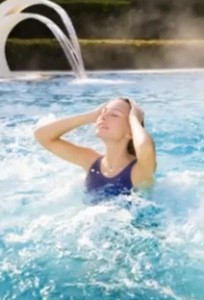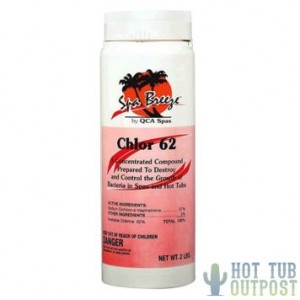 Bacteria can grow wild in hot, bubbly water, so it is important to maintain the proper sanitize level to keep bathers safe and the water fresh and clean.
Bacteria can grow wild in hot, bubbly water, so it is important to maintain the proper sanitize level to keep bathers safe and the water fresh and clean.
In a hot tub, if the water is kept an eye on, the water can remain for 3-4 months depending on use. It is a good idea to change the water every 3 months or so per most manufacturers recommendations.
A hot tub may have an installed ozonator, UV light system, mineral sticks, enzymes or other water treatment alternative, but always will require a minimal amount of sanitizer to augment the other water purification systems that are in place. Without any additional water purification devices or additives, the amount of bromine or chlorine in the water should be at an acceptable level to kill bacteria effectively.
Should I use bromine or chlorine?
There is no right answer because both chemicals do a great job of controlling the growth of bacteria in a hot tub.
Benefits of bromine include the fact that it is longer lasting, tends to smell less and can easily be dosed into the spa water by a floating bromine puck holder or integrated chemical dispenser such as those found in QCA Spas and other brand hot tubs that use the bromine dispenser as part of the Waterway or CMP filter systems.
Benefits of chlorine include the widespread availability and the habitual use of chlorine in other parts of our lives including shower water and home water treatment. Chlorine is often added in the form of granular chlorine to the water, whereas bromine is most often added in puck form. Beware that not all chlorine is equal for hot tub use. Do not use trichlor tablets meant for swimming pools in hot tubs. Trichlor are usually larger slow dissolving tablets that are very acidic and that can adversely affect hot tub pH. Do not add the dichlor chlorine tablets directly to the hot tub as it should not rest on the arylic. Also Calcium Hypochlorite should be avoided as it requires that addition of a stabilizer to be effective and has side effects in the water including deposits on heater elements and gaskets. Never use Sodium Hypochlorite either (bleach) as it does not work in the hot temperatures of a spa and adversely affects pH as well.
Use a chemical feeder. You can also use liquid chlorine or most popular, granular chlorine.
Another rule is to never mix bromine and chlorine. Choose one method of sanitizing and stick with it.
Many test strips on the market today will test for both chlorine and bromine.
Bromine tends to do better in hot water than chlorine because the off-gassing temperature of bromine is much higher than chlorine, so it lasts longer in hot water.
After deciding on which sanitizer is best for you, you should also know about shock treating the water weekly to reactivate the bromine or chlorine in the water. Sometimes if the water smells like chemicals, it is not that there is too much chlorine or bromine, but instead there are chloramides and bromamides that need to receive a shock treatment.
In the hot tub it is the free chlorine or free bromine that actually kills bacteria. Once it combines with other organics in the water thought, it becomes combined chlorine (chloramine) or combined bromine (bromamide). This stuff smells like chemicals x 10 and you will recognize it. That does not mean pouring more sanitizer into the water, it means the chlorine or bromine needs a shock treatment.
The fallout for not maintaining enough free sanitizer in the water is cloudy, smelly water or even algae. Red, burning and itching eyes are a telltale result of too many of these combined chemicals in the water.
 A non-chlorine shock treatment will break up the combined chlorine or bromine in the water. The most popular form of this is potassium monopersulfate. Leave the cover off for at least an hour so gasses can escape after shocking the water.
A non-chlorine shock treatment will break up the combined chlorine or bromine in the water. The most popular form of this is potassium monopersulfate. Leave the cover off for at least an hour so gasses can escape after shocking the water.
Once shocking does not work anymore, it is best to change the water.
The above just relates to hot tub sanitizer use, but pH is also an important factor in maintaining water quality and should always be held between 7.2-7.6.
So the first step to maintaining great hot tub water quality is to choose your sanitizer. Which one will it be, bromine or chlorine? Although the video mentions that chlorine is more popular, feedback from all over the world gives us the result that the use of either bromine or chlorine is about 50/50 in hot tubs, so there is no right answer.
We prefer bromine because it is a little easier to handle and lasts longer in hot water. Just add bromine pucks to a feeder and dose them by opening or closing the feeder such that bromine test strips always yield an acceptable result. Shock the water regularly, keep an eye on the pH and enjoy your hot tub.